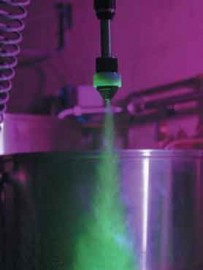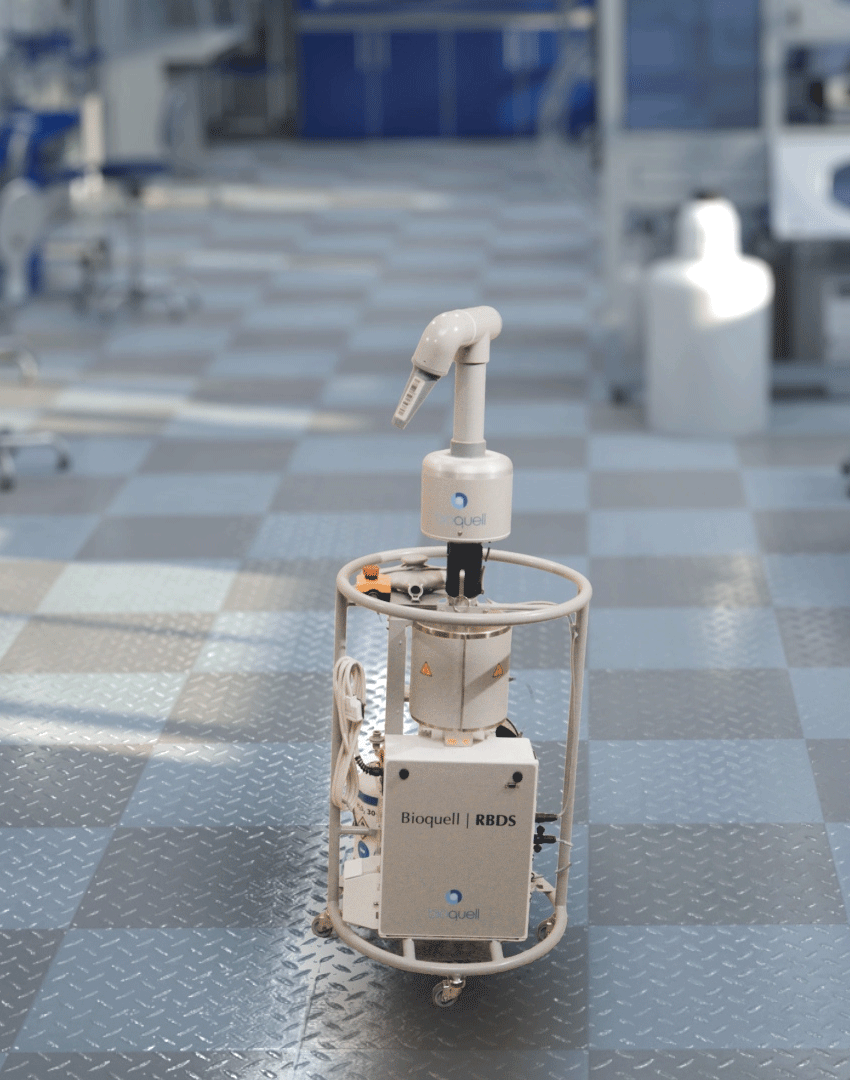End of production cleaning and disinfection is selective to food contact surfaces and can lead to the potential survival of micro-organisms in the wider environment. Whole room disinfection enables difficult-to-reach places to be thoroughly disinfected, as Dr Karen Middleton, of Campden BRI, explains.
During manufacture, food can be exposed to microbiological cross-contamination from surfaces and the air, which may give rise to food spoilage and safety issues. The traditional approach to controlling such contamination has been to implement cleaning and disinfection regimes. This targeted approach may be sufficient to maintain day-to-day control of contamination, but does not necessarily eliminate all environmental micro-organisms and, in some instances, they can persist in factories for several years.
In high-risk food factories thorough disinfection of surfaces is required to reduce the numbers of micro-organisms and to prevent transmission of potential contaminants. The belief is that regular use of novel disinfection techniques that can decontaminate the whole area will further reduce the number of environmental micro-organisms, which will in turn improve the quality of the food being produced, thereby reducing wastage and increasing profitability.
Both the pharmaceutical and clinical sectors have been targeted by a range of whole room type decontamination systems, but their practical operation and benefit in the food and drink industry is relatively unknown. The range of techniques is increasing, but those that are commercially available include:
- chemical fogging
- vaporised hydrogen peroxide
- ozone
- chlorine dioxide
- ultraviolet light
- titanium dioxide coating and UV light
- ionisation
Critical factors to address before using these techniques include: identifying areas where the decontamination processes can be applied, any health and safety issues related to using the technique and the practical considerations related to their use in the food processing environment. The level of disinfection that these systems can achieve also needs to be determined, as some may achieve decontamination of all exposed room surfaces, such as ceilings, walls, floors and equipment, while others may include some penetration into equipment to contact indirectly exposed surfaces. They may also provide disinfection of the air in the area being treated.
Chemical fogging: Applying chemical disinfectants to production areas as fogs or mists is a method used routinely in the food industry. The purpose is to create and disperse a disinfectant aerosol to reduce the numbers of airborne micro-organisms and also to apply disinfectant to surfaces that may be difficult to reach. Fogging is achieved using either a static, purpose-built system in a factory area with strategically placed nozzles or, more commonly, a mobile unit.

An electrostatic fogging nozzle
The equipment supersaturates the atmosphere with a disinfectant fog; the area covered will vary depending on the application system being used. A built-in system will typically be used for production areas >200m3, with mobile units usually being employed for areas <200m3,. Under typical conditions, fogging is carried out for a minimum of 15–30min to enable the fog to disperse and the chemical action to occur. After fogging, an additional period of 45–60min is required to allow the droplets to settle out of the air and onto the surfaces. Electrostatic charging of chemical fogs during aerosolisation can improve the application as the droplets will be attracted to surfaces that are electrically charged.
Vaporised hydrogen peroxide (VHP): Due to its rapid degradation into innocuous by-products, fumigation with VHP is a technique that has been widely used for disinfection of the pharmaceutical environment, including cleanrooms and production filling lines, and therefore may be an alternative to chemical fogging for the food industry. Mobile systems can be used throughout the factory environment, or areas can be equipped with ports to which the equipment is docked while the decontamination is carried out.
A typical decontamination cycle consists of four phases in a one-step process: dehumidification to below 40%; condition-ing, where the aqueous solution of hydrogen peroxide at 30 or 35% w/w is vaporised; decontamination, which consists of a steady injection and re-circulation of the vaporised hydrogen peroxide to maintain the concentration, typically 0.1–3.0mgL-1 at 25°C for 2–4hrs; and aeration, which is generally achieved by passing clean air into the room and removing the peroxide by dilution. However, some manufacturers supply aeration equipment that enhances the decomposition process by passing the air/vapour mixture through a carbon filter.
Ozone: High reactivity, penetrability and spontaneous decomposition into a non-toxic product make ozone a viable disinfectant for use in food production areas. Due to its reactive, unstable nature, ozone is produced at the point of use. Ozone generators effectively pass air through a high-energy source, such as UV light or corona discharge within the equipment, which leads to the formation of ozone. A typical decontamination cycle consists of three phases in a one-step process: humidification to 70–80%; decontamination, where the ozone vapour concentration increases rapidly to 8–25ppm and is maintained at an optimum biocidal level by the ozone generator; and aeration. One manufacturer utilises a biocidal quenching agent that further mops up the remaining ozone leaving the room clean, safe and fresh for immediate re-occupation. Cycle times vary depending on the area volume, desired level of decontamination and area contents, but are typically between 30 and 90min.
Chlorine dioxide: ClO2 gas is considered environmentally friendly as it rapidly breaks down into innocuous sodium salts. It is unstable and therefore is generated at its site of use by various chemical and electro-chemical methods. It has been shown to be effective at 2mg L-1 and at >65% relative humidity for 12hrs. Mobile and fixed ClO2 generator systems that allow automation of the application are commercially available.
A typical decontamination cycle operates at ambient temperature, between 25–30°C, and consists of three phases in a one-step process: humidification to 70–90%; decontamination, where the gas is generated in situ from dry sodium chlorite and chlorine gas in a nitrogen carrier, and is injected into the room at a concentration between 0.5–30mg L-1; and aeration by neutralisation of the gas with sodium bisulphite to a concentration below 0.1ppm.
Ultraviolet light: Conveyor belt systems and barrier tunnels have been developed and portable UV lamps have been designed to enable disinfection to be carried out on surfaces where a dry chemical-free disinfection method is required. The benefit of UV light is that it is a non-contact method, no chemicals are used and therefore there is no taint or residue. UV light in the range of 185–400nm, also known as UV-C, has been shown to be antimicrobial, with the optimum germicidal wavelength at approx. 254nm.
The UV-C is generated by either low-power systems with lamp ratings of 15–100W or more powerful medium-pressure arc tubes with ratings of 0.5–5kW. To decontaminate an area, a portable UV lamp is placed in the centre of the room and the lamp is activated by a wireless remote. Once activated, an array of sensors within the equipment measure the germicidal UV-C energy reflected back to the unit and calculate the time required effectively to provide disinfection to all shaded areas within the room.

Hydrogen peroxide vapour distribution nozzle (image courtesy of Bioquell)
Titanium dioxide/ultraviolet light: Surface coatings have been developed using nanotechnology that make surfaces easier to clean or ‘self-cleaning’. One coating, widely used due to its non-toxicity, chemical stability and capability for repeated use without the loss of catalytic activity, is titanium dioxide (TiO2).
This coating can demonstrate two photo-induced responses: the first is photocatalytic and activated by the presence of UV light at wavelengths <385nm, and the second is a super hydrophilic response that reduces the surface tension of water on the surface and improves cleanability. When the TiO2 coating absorbs UV radiation from sunlight or an illuminated light source, in the presence of oxygen and water, it will produce pairs of electrons and holes as the electron of the valence band of TiO2 becomes excited. The excess energy of this excited electron promotes the electron to the conduction band of TiO2, creating a negative-electron and a positive-hole pair. This stage is referred to as the 'photo-excitation' state. The positive-hole of TiO2 breaks apart any water molecules present to form hydrogen gas, H2O2 and hydroxyl radicals (OH-) and the negative-electron reacts with oxygen molecules to form super oxide anions (O2-). These radicals are able to destroy bacteria and will therefore be effective in reducing bacterial contamination on coated surfaces.
Ionisation: This involves air, that naturally contains moisture, being passed over ionising tubes emitting a high voltage discharge, such as a corona, to produce positively and negatively charged ions, such as hydroxyl radicals (OH-) and super oxide anions (O2-). These ions attract the naturally charged airborne micro-organisms, inactivate and remove them from the air. Constant disinfection is maintained by distributing a controlled amount of positive and negative ions.
Some commercial units combine non-thermal plasma and UV catalysis to produce a continual supply of hydroxyl radicals to destroy micro-organisms both in the air and on surface contact. The hydroxyl radicals that condense on contaminated surfaces can kill the bacteria within hours. This technology can be adapted to specific environments and applied as portable stand-alone units or incorporated into HVAC systems.
More information on the use, advantages and disadvantages of whole room disinfection techniques can be found in Campden BRI Review 63: Whole room disinfection – a review of current methods. (www.campden.co.uk/publ/pubs.asp).
CONTACT Dr Karen E. Middleton, Technical Contracts Manager, Food Hygiene Department Campden BRI Station Road, Chipping Campden Glos. GL55 6LD, UK T +44 1386 842042 k.middleton@campden.co.uk www.campden.co.uk
